Abstract
Subway systems are highly vulnerable to disasters because of their confined underground structures and limited evacuation routes, making accurate evacuation analysis essential for reducing casualties. Most existing studies overlook panic behavior, leading to unrealistic assessments of evacuation efficiency. This study develops a modeling framework that integrates panic behavior into agent-based subway evacuation simulations. The framework incorporates three behavioral factors: reaction delays to emergency cues, hesitation at decision points, and irrational route choices. Simulation experiments were conducted under different occupancy conditions, and results from panic-integrated and non-panic scenarios were compared. Findings show that the inclusion of panic significantly prolongs evacuation time, with delays of up to 30% in full-scale scenarios due to congestion and route errors. These outcomes demonstrate that panic behavior exerts a decisive influence on evacuation dynamics and should not be neglected in simulation studies. Incorporating panic into evacuation modeling provides a more realistic basis for designing safer subway systems and developing effective emergency response strategies.
1. Introduction
Emergency evacuation planning in underground public transportation facilities such as subways is critical to minimizing casualties. Subway stations are enclosed spaces with high passenger density and limited exits. Once an accident occurs, panic and confusion can quickly escalate into large-scale disasters []. The 2003 Daegu subway fire illustrates this danger. Arson led to 192 deaths and 148 injuries, highlighting the urgent need for effective evacuation safety measures in subways []. Evacuation under panic conditions is unpredictable and risky. Full-scale experiments under real conditions are nearly impossible. For this reason, computer-based simulations are widely used. Simulations reproduce large-scale evacuation scenarios while saving time and cost, and without endangering participants []. They also allow the modeling of underground hazards such as smoke, darkness, and blocked exits, making them a core tool in subway evacuation research.
Traditionally, microscopic models such as cellular automata and the social force model have been used. These approaches analyze crowd density, flow, and bottlenecks. Helbing and Molnár [] revealed the “faster-is-slower” effect, showing that excessive competition for speed under panic can reduce overall evacuation efficiency. However, most models assume rational evacuees or represent panic only as probabilistic variation or force adjustment. Such simplifications fail to capture the unique characteristics of panic. In actual emergencies, evacuees may freeze upon hearing alarms or delay evacuation due to poor judgment. Cognitive delays, hesitation, and confusion can greatly prolong initial response times []. Other irrational behaviors are also observed. At intersections, evacuees may hesitate or ignore the nearest exit, choosing instead familiar routes or simply following others. This often causes heavy congestion at some exits while leaving others unused []. Such panic-driven behavior not only reduces evacuation efficiency but also triggers secondary disasters, such as crowd crush incidents, sometimes causing more casualties than the initial hazard [].
To address these issues, agent-based modeling (ABM) has been increasingly applied. ABM represents each individual as an autonomous agent with attributes such as walking speed, age, gender, environmental familiarity, decision rules, response time, and panic level. This approach enables integrated modeling of physical constraints (e.g., corridor capacity, obstacle avoidance), social interactions (e.g., herding), and psychological factors (e.g., panic, hesitation). ABM therefore offers a realistic way to reproduce complex panic phenomena. By capturing subtle differences in individual behavior, ABM-based evacuation simulations can provide more precise planning and safety evaluation. Despite these advances, panic modeling remains underdeveloped or absent in many studies. Existing approaches to fear contagion and irrational behavior remain in early stages. Most research has focused on facility layout or general evacuation strategies, while panic-specific variables observed in real disasters are insufficiently modeled. Ignoring these factors risks overly optimistic evaluations and underestimation of hidden risks. Recent studies have incorporated panic-related behaviors into agent-based models of crowd evacuation. However, most of these efforts focused on single behavioral factors or small-scale environments. In contrast, this study simultaneously implements three panic behaviors—reaction delay, cognitive impairment, and irrational route choice—within a dense underground subway environment to evaluate their combined influence on evacuation performance.
Recognizing this limitation, the present study conducts an agent-based case study of Dongsu Station on Incheon Subway Line 1, a representative underground subway facility in South Korea. Panic behaviors—including delayed initial response, hesitation at multiple decision points, and irrational route choice—are explicitly modeled and analyzed. The results highlight the crucial role of panic modeling in subway evacuations and its significance for disaster preparedness strategies. The findings contribute to advancing evacuation simulation techniques and supporting practical applications for underground safety planning.
2. Related Work (Literature Review)
Psychological studies have traditionally assumed that people behave irrationally during disasters, acting only out of self-preservation []. In contrast, many empirical studies in the social sciences show a different picture. Cooperative and orderly behavior is often observed in real emergencies. Quarantelli [] reported that the concept of mass panic is frequently overstated, and that most citizens maintain prosocial behavior even in extreme situations. Still, in enclosed spaces or when evacuation time is severely limited—as in fires—groups can suddenly fall into disorder. Panic may arise and lead to irrational behavior []. Large-scale fires and terrorist attacks have shown cases where fear caused people to push, stumble, and trample, sometimes ending in fatal stampedes []. Another well-documented phenomenon is cognitive delay. Even after hearing alarms, people often hesitate to evacuate, checking the situation or collecting belongings first. Such initial delays strongly affect total evacuation time. Understanding these complex behaviors is therefore essential to building realistic evacuation models.
Many computational models have been proposed to simulate evacuation. They can be broadly divided into continuum-based physical models and discrete agent-based models. Continuum models describe overall crowd flow using mathematical equations. A well-known example is the Social Force Model, which treats pedestrians as particles subject to repulsive and goal-directed forces. It reproduces collective motion and has explained panic-related effects such as bottleneck congestion and the paradoxical “faster-is-slower” effect, where rushing toward exits delays evacuation and creates arch-shaped jams. These models capture physical interactions well but cannot explicitly represent decision-making or psychological states.
Discrete models include cellular automata (CA) and agent-based models (ABM). The CA approach divides space into grids and moves pedestrians step by step according to rules. For instance, Burstedde et al. [] applied the floor field method in a two-dimensional CA model to simulate pedestrian flow under congestion and limited visibility. CA models are efficient and easy to implement. They are widely used for large-scale evacuation scenarios and for evaluating design factors such as exit placement and corridor width. However, because they rely on sequential rules, CA models struggle to represent fine interactions or flexible responses in continuous space.
ABM, by contrast, treats each person as an autonomous agent with explicit rules for decision-making and interaction. This makes it possible to incorporate cognitive processes, psychological states, and behavioral changes. For example, an agent’s route choice can depend on exit visibility, crowd density, or neighbor information. ABMs can also model communication, leader–follower dynamics, and heterogeneous traits. This flexibility has made ABMs popular for evaluating evacuation strategies in buildings, mass gatherings, and other complex scenarios [].
Efforts to include panic behaviors have been made in both physical and cognitive models. Helbing et al. [] added a disorder factor to the Social Force Model to reproduce abnormal movements, though without psychological realism. Pires [] modeled cognitive decision delays in fire evacuations by including perception, confirmation, and decision stages, improving prediction accuracy. Later, VR-based experiments extended this approach. Other studies have borrowed epidemic SIR-type models or information-sharing rules to reproduce fear contagion []. Pan et al. [] combined social psychology with a cognitive framework to reproduce social proof, where individuals follow the majority’s route choice. More recent work assigns heterogeneous traits such as fear sensitivity or altruism, and uses emotional contagion models so nearby agents synchronize fear levels. The overall trend is to integrate cognition, emotion, and social interaction for more realistic panic modeling.
In summary, previous evacuation models face two main limitations. First, panic behavior is often oversimplified or ignored. Many models assume rational, homogeneous actions and fail to reproduce irrational or heterogeneous behaviors seen in real disasters. Even when panic is included, it is usually represented only by faster walking or random route choice, which cannot capture real complexity. Second, many models lack realism because they exclude cognitive or psychological variables. This reduces predictive accuracy and risks providing misleading evidence for evacuation planning.
To overcome these shortcomings, this study implements panic behavior modules in an agent-based model for subway evacuations. Three behaviors are included: delayed response after alarms, hesitation at intersections, and irrational route choice (e.g., moving toward restrooms or dead ends). By explicitly incorporating these panic factors, the model provides a more realistic tool to test and improve evacuation plans for enclosed subway spaces. The analysis of irrational behaviors and system vulnerabilities under panic is expected to yield more reliable predictions and help establish robust disaster preparedness strategies.
The modeled subway station represents a typical side-platform underground station on the Incheon Metro Line 1 network, consisting of two tracks and two separate platforms. Each platform is approximately 180 m in length and 12 m in width, located about 15 m below ground level, which corresponds to the configuration of medium-sized Korean subway stations. A total of 600 evacuees was modeled to represent peak-hour crowd conditions, derived from an effective platform area of about 1200–1440 m2 and a design occupant density of 0.5 persons per square meter. The panic scenario was introduced to reflect human behavioral uncertainty during emergencies, assuming fire-alarm activation and visible smoke near the center of the platform as the triggering event. This physical and behavioral setting provides the basis for the subsequent simulation and analysis presented in the following sections.
3. Behavioral Characteristics of Panic in Evacuation Situations
During disasters or emergencies, normally orderly human behavior can change dramatically. Fear and confusion make actions unpredictable. Under extreme stress, cognitive abilities decline, emotional contagion spreads, and herd psychology intensifies. These factors interfere with decision-making and often lead to irrational behaviors in route choice, response time, and overall evacuation performance.
- Cognitive Impairment Under Stress
Strong stress reduces memory, judgment, and attention span. In evacuation situations, people often hesitate at intersections and appear indecisive. Fire emergencies show that psychological stress slows route recognition and decision-making, creating confusion []. The Canadian government has also identified memory loss, indecision, disorientation, and loss of spatial awareness as common stress-related symptoms during evacuation [].
- Fear and Emotional Contagion
Fear and anxiety spread quickly in crises. Emotional contagion refers to the unconscious transfer of fear from one person to another, accelerating the formation of panic in the crowd []. Studies show that the higher the density, the stronger the collective panic becomes. Fear not only clouds individual judgment but also shapes group behavior. Even minor anxiety can quickly escalate into widespread confusion. Controlling fear in the early stages of an emergency is therefore critical.
- Herd Behavior and Crowd Psychology
Herd behavior describes the tendency to follow the majority in emergencies. Under panic, people rely less on their own judgment and more on the actions of others. This can lead to irrational outcomes. For example, evacuation experiments show that while individuals instinctively prefer the nearest exit, they often follow the crowd when others move toward a different route []. Such behavior can overload some exits while leaving others unused.
- Irrational Route Choice
Irrational route choice occurs frequently under stress. Instead of selecting the nearest or safest exit, evacuees may revert to familiar or misperceived routes. Studies show that nearly half of evacuees return to their entry path rather than use the closest emergency exit, reflecting a bias for familiarity. Video analyses reveal behaviors such as backtracking or choosing a distant exit. In many cases, evacuees misperceived the distant exit as being closer to the main staircases []. Such errors reduce evacuation efficiency and increase risk.
- Reaction Delay (Pre-movement Time)
Reaction delay is the time between perceiving danger and starting to evacuate. Research highlights that this pre-movement phase accounts for a large share of total evacuation time. Fire cases have reported casualties caused by evacuees who ignored alarms for several minutes before moving []. Pires [] emphasized that hesitation in interpreting alarms as real danger can have fatal consequences. Many people wait to observe others or confirm the situation, which prolongs evacuation and increases exposure. Rapid response is therefore essential.
- Tunnel Vision Effect
Extreme fear narrows attention, creating tunnel vision. People focus on one object or direction and fail to notice important cues. During evacuations, tunnel vision prevents recognition of nearby exit signs or alternative routes. Instead, evacuees may fixate on fire or smoke while missing safe escape options []. This cognitive tunneling reduces the effectiveness of signage. Evacuation systems must therefore be designed to remain visible and intuitive even under restricted vision.
- Changes in Movement Speed
Movement speed varies widely in emergencies. Some individuals run faster due to adrenaline, sometimes pushing others aside. Vulnerable groups—such as the elderly, children, or the disabled—move much more slowly even under panic. As density rises, people obstruct each other, reducing speed overall. Severe congestion occurs at exits and corridors, producing bottlenecks. This explains the paradoxical “faster-is-slower” effect, where rushing increases total evacuation time []. Panic therefore creates both speeding and congestion, with sudden fluctuations that strongly influence efficiency.
- Information Overload
Emergencies often overwhelm people with excessive information in a short time. Information overload occurs when the amount of input exceeds working memory capacity. During fires, evacuees may face simultaneous alarms, loudspeaker announcements, shouting, and numerous signs. Research shows that high information load reduces decision quality and increases stress []. Confusing or contradictory instructions can delay evacuation and foster distrust. Effective communication should therefore limit and simplify messages so evacuees can focus on essential instructions.
4. Panic Simulation Methodology
This section describes the methodology used to implement panic behavior within the evacuation simulation framework. It explains how the behavioral characteristics discussed earlier were parameterized and integrated into the agent-based model. During disasters or emergencies, normally orderly human behavior can change dramatically. Fear and confusion make actions unpredictable. Under extreme stress, cognitive abilities decline, emotional contagion spreads, and herd psychology intensifies. These factors interfere with decision-making and often lead to irrational behaviors in route choice, response time, and overall evacuation performance. The advanced evacuation simulations were conducted using an in-house agent-based evacuation modeling platform developed by iCAPTAIN Co., Ltd. (Incheon, Republic of Korea). This customized tool was designed to reproduce detailed pedestrian dynamics in complex built environments, such as underground subway stations, allowing high-resolution scenario-based analysis. Panic behaviors were implemented through three behavioral modifiers applied at the individual-agent level: reaction delay, cognitive impairment, and irrational route choice. The following subsections describe the modeling details of each behavior.
4.1. Reaction Delay (Pre-Movement Time)
In an evacuation, individuals require time to perceive danger before taking action. This delay, known as pre-movement time, varies significantly among individuals. To model this behavior, we referred to the response duration data presented in Section 3.2.2 of the International Maritime Organization guideline MSC.1/Circ.1533 []. The guideline defines response duration as the time between alarm perception and the start of evacuation, and recommends modeling it with a truncated log-normal distribution. Different parameters are suggested for day and night scenarios, reflecting variations in evacuee states and situational awareness.
Experimental studies confirm that passenger response times follow log-normal distributions [], supporting the IMO assumption. Based on these findings, we assigned probabilistic response delays to each agent so that evacuation did not begin simultaneously. This approach reproduces the asynchronous onset of evacuation observed in reality. Equations (1) and (2) define the log-normal distributions for night and day scenarios, respectively.
Figure 1 shows the probability curves, while Figure 2 illustrates the impact of reaction delay on evacuation outcomes. Nighttime delays were set in the 400–700 s range, while daytime delays ranged from 0–300 s. These parameters reflect the effect of time of day on perception and evacuation initiation.
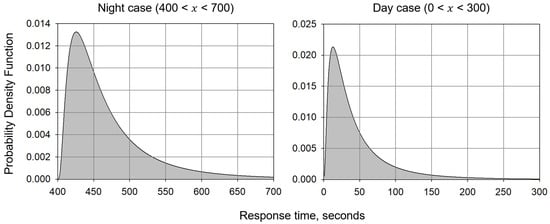
Figure 1.
Response duration distribution curves for day and night scenarios based on IMO guidelines.

Figure 2.
Crowd evacuation simulation with applied reaction delay.
4.2. Irrational Route Choice
Evacuees do not always choose the shortest or safest routes. Under stress, they may misinterpret signage, follow others, or revert to familiar paths. In underground environments, reduced visibility and complex intersections further increase the likelihood of poor decisions [].
To implement this, the 3D model of Dongsu Station was modified with intentional irrational destinations, such as restrooms and blocked corridors. Agents arriving at these points were programmed to follow a “stop–search–redirect” sequence. After failing to find an exit, they resumed movement toward available exits.
Zhu et al. [] reported that social influence can reduce correct route choice by about 30%. Since this reflects extreme laboratory conditions, we adopted a conservative value of 15% for initial mis-selections, balancing realism with environmental constraints. Figure 3 shows the conceptual sequence for irrational route choice, while Figure 4 identifies the irrational destinations placed within the B1 and B2 levels of Dongsu Station.

Figure 3.
Conceptual sequence for implementing irrational route choice.
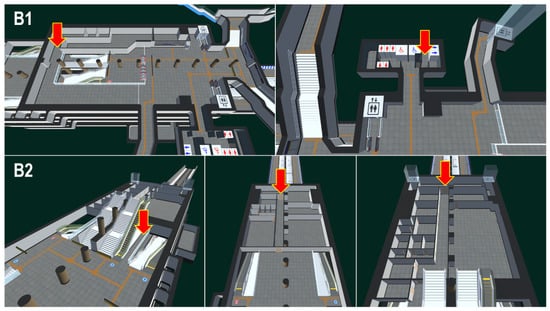
Figure 4.
Irrational destinations defined on the first and second basement levels of Dongsu Station.
4.3. Cognitive Impairment at Decision Points
Stress impairs cognitive ability, especially at intersections or junctions. Evacuees may hesitate, slow down, or wander aimlessly. Carlson et al. [] reported that evacuees under stress often show delayed decision-making and reduced speed. Helbing et al. [] also demonstrated that hesitation at intersections increases local density and worsens bottlenecks.
To represent this, agents entering decision zones had their walking speed reduced to 75% of the baseline. This assumption was based on Bae et al. [], who experimentally observed 23–47% speed reduction at intersections, with greater delays during turns than straight movements. Our chosen value reflects the mid-range of observed data and avoids excessive slowdown.
In the Dongsu Station model, two junctions on the B1 and B2 levels were identified as areas likely to cause such delays. Figure 5 highlights these decision points where cognitive impairment effects were applied.

Figure 5.
Decision point zones with speed reduction due to cognitive impairment.
4.4. Summary
In summary, three panic behaviors—reaction delay, irrational route choice, and cognitive impairment—were quantitatively modeled and embedded into the agent-based simulation. These implementations capture panic dynamics observed in real disasters and address the limitations of conventional evacuation models, which often assume idealized rational behavior.
The next section presents the simulation results. We compare evacuation efficiency with and without panic modeling and evaluate differences in evacuation times under each condition.
5. Simulation Architecture and Evacuation Analysis
The proposed framework differs from previous models that separately examined individual panic effects. Here, the three interdependent panic behaviors are implemented together to capture their coupled impact on congestion and route deviation in confined subway spaces. The evacuation simulation framework in this study consists of five major modules: 3D CAD modeling, pre-processing, panic behavior model, global navigation, and crowd evacuation simulation. The system operates at the individual agent level and iterates in a loop until all agents complete evacuation. Figure 6 illustrates the overall architecture, including the integrated panic behavior module.
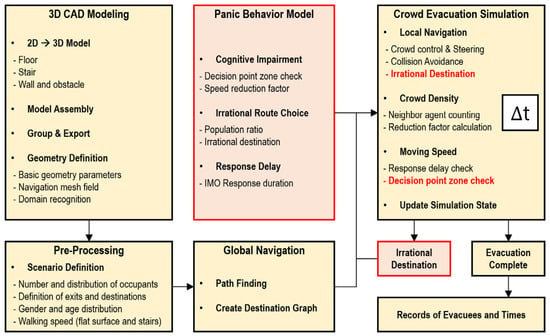
Figure 6.
System architecture of the crowd evacuation simulation with integrated panic behavior model.
5.1. 3D CAD Modeling and Spatial Definition
The first step was 3D CAD modeling of the station environment. Two-dimensional facility drawings were converted into three-dimensional representations of floors, stairs, walls, and obstacles. These elements were grouped and assembled into a unified model.
Next, basic geometric parameters such as wall boundaries and navigation meshes were defined. Domain recognition was then applied to establish the spatial structure required for agent movement.
5.2. Pre-Processing and Scenario Setup
In the pre-processing stage, simulation scenarios were defined. Parameters included the number and distribution of occupants, exit and destination points, demographic attributes such as gender and age, and walking speeds.
The panic behavior model, developed in this study, incorporated three key elements:
- Cognitive impairment—applied at decision point zones, where speed reduction and hesitation were modeled.
- Irrational route choice—a set proportion of agents initially selected irrational destinations such as restrooms or blocked corridors.
- Response delay—modeled based on IMO guidelines for response duration, assigning probabilistic delays between alarm recognition and evacuation onset.
Additional explanations of the parameter sources and modeling assumptions are summarized as follows. The parameters (μ = 3.95, σ = 0.84) used in the log-normal distributions for reaction delay were derived from the IMO guideline MSC.1/Circ.1533, which defines coefficients for pre-movement times under day and night conditions. These parameters were calibrated to reproduce realistic response durations (0–700 s) reported in subway evacuation studies. The 15% ratio of irrational route choice was selected as a conservative mid-value, considering laboratory observations of roughly 30% route misselection caused by social influence []. This ensures behavioral diversity without over-representing extreme panic effects. The 75% walking-speed reduction at decision points was applied independently of the density-based reduction formula (Equation (3)), representing cognitive hesitation rather than congestion effects.
5.3. Global Navigation and Local Simulation
The global navigation module generated pathfinding graphs and defined the set of available routes for each agent. The crowd evacuation simulation then proceeded in four sub-modules:
- Local navigation—included crowd control, steering, collision avoidance, and panic-induced irrational destinations.
- Crowd density—calculated the number of nearby agents and adjusted speed reduction coefficients accordingly.
- Moving speed—dynamically updated based on reaction delay and decision point checks.
- Update simulation state—refreshed each agent’s status, recording evacuation time upon completion.
Collision avoidance was handled using the Reciprocal Velocity Obstacles (RVO) algorithm []. Unlike the basic Velocity Obstacles (VO) approach [], RVO accounts for reciprocal interactions, enabling efficient avoidance in dense multi-agent environments. For density effects, we adopted the quadratic approximation speed reduction formula proposed by Kim et al. [], which captures the relationship between crowd density and walking speed. Equation (3) is the quadratic approximation of speed reduction by crowd density.
5.4. Baseline and Panic Scenarios
In the baseline scenario (without panic behaviors), all agents followed normal route selection and walking speeds. No reaction delays, irrational routes, or hesitation at intersections were included. Figure 7 shows the baseline simulation results, which serve as a reference for comparison.
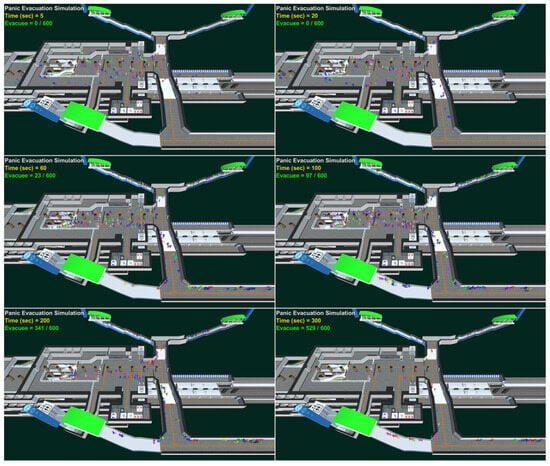
Figure 7.
Baseline evacuation simulation without panic behavior.
When panic behaviors were included, several changes emerged:
- Response delay caused staggered evacuation onset.
- Cognitive impairment reduced walking speed at decision points, creating localized congestion.
- Irrational routes diverted some agents to restrooms or blocked corridors, requiring redirection.
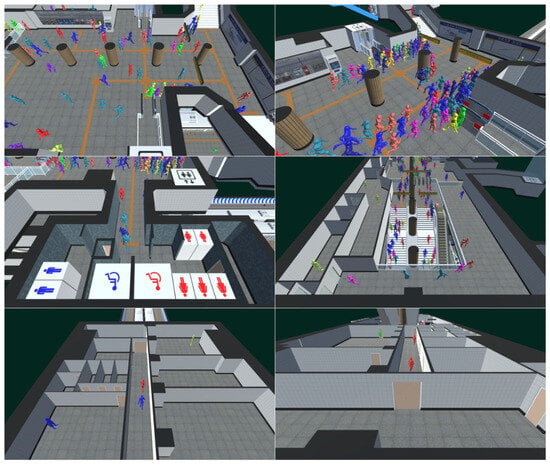
Figure 8.
Evacuation simulation results with panic behavior model.
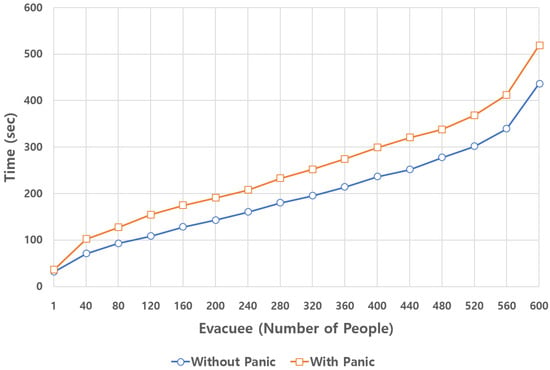
Figure 9.
Comparison of total evacuation times with and without panic behavior.
Figure 4, Figure 5 and Figure 7 illustrate the overall geometry of Dongsu Station and the simulated evacuation flow. The main evacuation routes extend along the central concourse and the stairways leading to Exit 2. Temporary delays caused by irrational route choice were observed near the restrooms and blocked corridors on the B2 level, where several evacuees initially moved in the wrong direction before rejoining the main flow. Figure 8 and Figure 9 illustrate the impact of panic modeling on evacuation performance. In the baseline scenario, evacuees were assumed to know the exit locations and moved directly toward them along the shortest routes, resulting in smooth and stable flow. Under panic conditions, however, a portion of evacuees exhibiting irrational route choice temporarily deviated toward non-exit areas such as restrooms or closed corridors before correcting their direction. This misjudgment created cross-flows and local congestion near intersections, which are visible in Figure 8 as denser clusters around Exit 2.
As shown in Figure 9, the overall evacuation under panic conditions was delayed by approximately 80 s compared with the non-panic case. This difference remains nearly constant in the later stage because, once both groups reach the exits, the outflow becomes limited by the fixed geometric capacity rather than behavioral effects. Hence, panic primarily affects the early response and route-selection phase, whereas the final discharge phase is governed by exit capacity.
5.5. Quantitative Results
Simulations were repeated 20 times under identical conditions to ensure reproducibility. Average evacuation times were used for analysis.
- First evacuees exited at 30.7 s (without panic) and 35.1 s (with panic), a small 14.3% difference.
- 50% evacuation (300 people) occurred at 186.1 s (without panic) and 240.9 s (with panic), showing a 29.5% delay.
- 75% evacuation (450 people) occurred at 256.6 s versus 328.3 s, a 28% delay.
- Full evacuation (600 people) required 435.9 s versus 518.2 s, an 18.9% delay.
The results show close alignment in the early stage, but divergence grows in the mid and late stages. This pattern reflects cumulative bottlenecks and flow instability caused by panic factors.
- Reaction delay distributed evacuees’ start times but later created surges into corridors and staircases, intensifying bottlenecks.
- Cognitive impairment at decision points prolonged dwell times and reduced effective throughput.
- Irrational routes forced backtracking, generating reverse flows and additional interference.
5.6. Implications
A qualitative comparison indicated that irrational route choice had the largest effect on total evacuation time by causing detours and reverse flows, followed by cognitive impairment, which slowed movements at decision points. Reaction delay mainly influenced the initiation stage but had the smallest contribution to the overall delay.
The results indicate that models excluding panic behaviors risk overestimating mid- and late-stage evacuation performance. With panic included, evacuation time increased by 28–30% for 50–75% of evacuees and by 19% overall.
These findings highlight the importance of modeling panic as a mandatory, not optional, factor. Practical strategies include:
- simplifying decision points and improving visual guidance to reduce cognitive load,
- minimizing the visual attractiveness of non-exit areas to prevent misdirection, and
- optimizing early warning and guidance systems to shorten response delay.
The proposed simulation architecture and results provide a quantitative basis for validating such strategies and improving evacuation safety planning.
6. Conclusions and Future Work
This study conducted a crowd evacuation simulation for Dongsu Station on the Incheon Subway Line 1 in South Korea. Three core panic behaviors—reaction delay, cognitive impairment, and irrational route choice—were modeled and integrated into the simulation. The proposed architecture comprised five modules: 3D CAD modeling, pre-processing, panic behavior modeling, global navigation, and agent-based simulation. These modules operated iteratively at the agent level until all evacuees completed evacuation.
Simulation results showed a clear delay in evacuation speed during the mid and late stages when panic behaviors were incorporated. Total evacuation time also increased significantly compared to the baseline scenario. These effects were not only evident in average evacuation times but also more pronounced in cumulative evacuation curves and quantile-based indicators. The findings confirm that panic behaviors systematically degrade evacuation efficiency, and neglecting them risks overly optimistic assessments of evacuation safety.
The study highlights the necessity of incorporating panic modeling into evacuation analysis. Several mitigation strategies are suggested: simplifying intersections and decision points, strengthening visual guidance, restricting access to non-exit areas, improving signage, and optimizing alarm and communication systems to minimize reaction delay.
Future work should expand the proposed model to other environments such as large public facilities, tunnels, and high-rise buildings. Validation against empirical evacuation data will be essential to enhance model reliability. More refined behavior modeling is also required, incorporating heterogeneity in age, physical condition, and mobility limitations, as well as social interactions such as cooperation and rescue behaviors. Furthermore, integration with real-time sensor data and AI-based predictive techniques could transform evacuation simulations from analytical tools into core components of smart safety management systems.
In conclusion, this study provides empirical evidence of the importance of panic behavior modeling in evacuation simulations. The findings lay the groundwork for more realistic and reliable safety evaluations, offering not only academic contributions but also quantitative support for practical design and operational strategies in real facilities.
Author Contributions
Conceptualization, J.L. and H.K.; methodology, B.A.; investigation, H.K. and J.C.; resources, H.K.; data curation, J.C.; writing—original draft preparation, J.L.; writing—review and editing, B.A. and J.L.; visualization, J.L.; supervision, B.A. and J.L.; project administration, B.A.; funding acquisition, H.K. All authors have read and agreed to the published version of the manuscript.
Funding
This work was supported by a Korea Agency for Infrastructure Technology Advancement (KAIA) grant funded by the Ministry of Land, Infrastructure and Transport (Grant RS-2023-00238018).
Data Availability Statement
Data are contained within the article.
Conflicts of Interest
Author Hyuncheol Kim and Jaehyeok Choi are employed by the company i CAPTAIN Co., Ltd. The remaining authors declare that the research was conducted in the absence of any commercial or financial relationships that could be construed as a potential conflict of interest.
References
- Wu, J.; Hu, Z.; Chen, J.; Li, Z. Risk assessment of underground subway stations to fire disasters using Bayesian network. Sustainability 2018, 10, 3810. [Google Scholar] [CrossRef]
- Hong, W.H. The progress and controlling situation of Daegu subway fire disaster. Fire Saf. Sci. 2004, 6, s-5. [Google Scholar]
- Chen, Y.X.; Song, Y.H.; Huo, F.Z. Simulation of crowd evacuation behaviours at subway stations under panic emotion. Int. J. Simul. Model. 2023, 22, 667–678. [Google Scholar] [CrossRef]
- Helbing, D.; Molnar, P. Social force model for pedestrian dynamics. Phys. Rev. E 1995, 51, 4282–4286. [Google Scholar] [CrossRef]
- Joo, J.; Kim, N.; Wysk, R.A.; Rothrock, L.; Son, Y.J.; Oh, Y.G.; Lee, S. Agent-based simulation of affordance-based human be-haviors in emergency evacuation. Simul. Model. Pract. Theory 2013, 32, 99–115. [Google Scholar] [CrossRef]
- Senanayake, G.P.; Kieu, M.; Zou, Y.; Dirks, K. Agent-based simulation for pedestrian evacuation: A systematic literature review. Int. J. Disaster Risk Reduct. 2024, 111, 104705. [Google Scholar] [CrossRef]
- Pecio, M. Issues of crowd evacuation in panic conditions. Urban Sci. 2025, 9, 258. [Google Scholar] [CrossRef]
- Gantt, P.; Gantt, R. Disaster psychology: Dispelling the myths of panic. Prof. Saf. 2012, 57, 42–49. [Google Scholar]
- Quarantelli, E.L. The Sociology of Panic. In International Encyclopedia of the Social & Behavioral Sciences; Smelser, N.J., Baltes, P.B., Eds.; Elsevier: Oxford, UK, 2001; pp. 11020–11023. [Google Scholar]
- Trivedi, A.; Rao, S. Agent-based modeling of emergency evacuations considering human panic behavior. IEEE Trans. Comput. Soc. Syst. 2018, 5, 277–288. [Google Scholar] [CrossRef]
- Helbing, D.; Farkas, I.; Vicsek, T. Simulating dynamical features of escape panic. Nature 2000, 407, 487–490. [Google Scholar] [CrossRef]
- Burstedde, C.; Klauck, K.; Schadschneider, A.; Zittartz, J. Simulation of pedestrian dynamics using a two-dimensional cellular automaton. Phys. A Stat. Mech. Its Appl. 2001, 295, 507–525. [Google Scholar] [CrossRef]
- Kim, H.; Im, H.; Lee, S.; Ju, Y.; Kwon, S. Establishment of crowd management safety measures based on crowd density risk simulation. J. Korean Soc. Saf. 2023, 38, 96–103. [Google Scholar] [CrossRef]
- Pires, T.T. An approach for modeling human cognitive behavior in evacuation models. Fire Saf. J. 2005, 40, 177–189. [Google Scholar] [CrossRef]
- Liu, T.; Liu, Z.; Chai, Y.; Wang, J.; Lin, X.; Huang, P. Simulating evacuation crowd with emotion and personality. Artif. Life Robot. 2019, 24, 59–67. [Google Scholar] [CrossRef]
- Pan, X.; Han, C.S.; Dauber, K.; Law, K.H. A multi-agent based framework for the simulation of human and social behaviors during emergency evacuations. AI Soc. 2007, 22, 113–132. [Google Scholar] [CrossRef]
- Kobes, M.; Helsloot, I.; De Vries, B.; Post, J.G. Building safety and human behaviour in fire: A literature review. Fire Saf. J. 2010, 45, 1–11. [Google Scholar] [CrossRef]
- Government of Canada. Evacuations and Your Mental Health. Available online: https://www.canada.ca/en/health-canada/services/publications/healthy-living/evacuations-mental-health.html (accessed on 21 September 2025).
- Wu, W.; Zhang, Y.; Liu, H. Analyzing crowd emotional contagion in metro emergencies through the lens of the Weber–Fechner law: Predictions based on computational techniques. Appl. Sci. 2025, 15, 1244. [Google Scholar] [CrossRef]
- Chang, B.L.; Chang, H.T.; Lin, B.S.M.; Hsiao, G.L.K.; Lin, Y.J. Factors affecting emergency evacuation: Floor plan cognition and distance. Sustainability 2023, 15, 8028. [Google Scholar] [CrossRef]
- Forssberg, M.; Kjellström, J.; Frantzich, H.; Mossberg, A.; Nilsson, D. The variation of pre-movement time in building evacuation. Fire Technol. 2019, 55, 2491–2513. [Google Scholar] [CrossRef]
- Kwee-Meier, S.T.; Kabuss, W.; Mertens, A.; Schlick, C.M. Decision-making for adaptive digital escape route signage competing with environmental cues: Cognitive tunneling in high-stress evacuation situations. In Proceedings of the International Conference on Engineering Psychology and Cognitive Ergonomics, Cham, Switzerland, 22–27 May 2017; pp. 128–140. [Google Scholar]
- Oh, H.; Park, J. Main factor causing “faster-is-slower” phenomenon during evacuation: Rodent experiment and simulation. Sci. Rep. 2017, 7, 13724. [Google Scholar] [CrossRef] [PubMed]
- Arnold, M.; Goldschmitt, M.; Rigotti, T. Dealing with information overload: A comprehensive review. Front. Psychol. 2023, 14, 1122200. [Google Scholar] [CrossRef] [PubMed]
- International Maritime Organization (IMO). Guidelines for Evacuation Analysis for New and Existing Passenger Ships (MSC.1/Circ.1533); IMO: London, UK, 2016. [Google Scholar]
- Galea, E.R.; Deere, S.; Sharp, G.; Filippidis, L.; Lawrence, P.; Gwynne, S. Recommendations on the nature of the passenger response time distribution to be used in the MSC 1033 assembly time analysis based on data derived from sea trials. Int. J. Marit. Eng. 2007, 149, 15–29. [Google Scholar] [CrossRef]
- Kobes, M.; Helsloot, I.; De Vries, B.; Post, J.G.; Oberijé, N.; Groenewegen, K. Study on the influence of smoke and exit signs on fire evacuation: Analysis of evacuation experiments in a real and virtual hotel. In Proceedings of the 12th International Fire Science & Engineering Conference, London, UK, 5–7 July 2010; pp. 801–812. [Google Scholar]
- Zhu, Y.; Chen, T.; Ding, N.; Chraibi, M.; Fan, W.C. Follow the evacuation signs or surrounding people during building evacuation, an experimental study. Phys. A Stat. Mech. Its Appl. 2020, 560, 125156. [Google Scholar] [CrossRef]
- Carlson, J.M.; Alderson, D.L.; Stromberg, S.P.; Bassett, D.S.; Craparo, E.M.; Guiterrez-Villarreal, F.; Otani, T. Measuring and modeling behavioral decision dynamics in collective evacuation. PLoS ONE 2014, 9, e87380. [Google Scholar] [CrossRef]
- Bae, Y.H.; Kim, Y.C.; Oh, R.S.; Son, J.Y.; Hong, W.H.; Choi, J.H. Walking speed reduction rates at intersections while wayfinding indoors: An experimental study. Fire Mater. 2021, 45, 498–507. [Google Scholar] [CrossRef]
- Van den Berg, J.; Lin, M.; Manocha, D. Reciprocal velocity obstacles for real-time multi-agent navigation. In Proceedings of the 2008 IEEE International Conference on Robotics and Automation, Pasadena, CA, USA, 19–23 May 2008; pp. 1928–1935. [Google Scholar]
- Fiorini, P.; Shiller, Z. Motion planning in dynamic environments using velocity obstacles. Int. J. Robot. Res. 1998, 17, 760–772. [Google Scholar] [CrossRef]
- Kim, H.; Han, J.; Han, S. Analysis of evacuation simulation considering crowd density and the effect of a fallen person. J. Ambient Intell. Humaniz. Comput. 2019, 10, 4869–4879. [Google Scholar] [CrossRef]
Disclaimer/Publisher’s Note: The statements, opinions and data contained in all publications are solely those of the individual author(s) and contributor(s) and not of MDPI and/or the editor(s). MDPI and/or the editor(s) disclaim responsibility for any injury to people or property resulting from any ideas, methods, instructions or products referred to in the content. |
© 2025 by the authors. Licensee MDPI, Basel, Switzerland. This article is an open access article distributed under the terms and conditions of the Creative Commons Attribution (CC BY) license (https://creativecommons.org/licenses/by/4.0/).